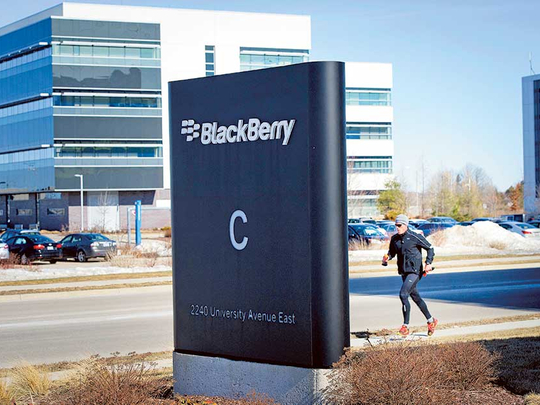
Dubai: BlackBerry is no longer about the smartphone, but the smart in the phone and in cars and containers, medical devices and ultimately the entire enterprise.
The Canadian company has exited the hardware business of the smartphone space and is focused on the software side.
BlackBerry, which is seeing a 30 per cent year-on-year increase in its software business, is looking at further strengthening its business by quitting its smartphone hardware business.
BlackBerry has started outsourcing the smartphone hardware business to local players in each country to manufacture and distribute the devices and focus more on software side of the smartphone business.
Two weeks ago, BlackBerry signed a cybersecurity deal with former New York Mayor Rudy Giuliani’s security management consulting firm at Las Vegas CES 2017.
Under the deal, Giuliani Partners will use the company’s BlackBerry Secure platform in its cybersecurity consulting services for government, individuals and business customers.
With Giuliani becoming the cybersecurity adviser to the US President, the company is expected to gain further ground.
At the event, Blackberry took the wraps off its latest generation of its in-car operating system, QNX SDP 7.0, which it claims takes security as well as reliability to another level.
BlackBerry’s QNX software is deployed in 60 million vehicles on the road today and by 40 automakers worldwide.
Over the last few years, BlackBerry has transitioned to a security software and services company that is dedicated to securing the Enterprise of Things (EoT).
The Enterprise of Things is the network of intelligent connections within the enterprise that enable products to move from sketch to scale. It is a collection of devices, computers, sensors, trackers, equipment and other ‘things’ that communicate with each other.
The enterprise of Things exists behind the consumer-facing Internet of Things and enables it to thrive.
Nader Henein, Regional Director for Advanced Security Solutions — Advisory Division at BlackBerry, said that the market demand for security is shifting from the network of computers to the network of endpoints.
“BlackBerry is uniquely qualified to address this emerging market need because of our legacy leadership and ongoing innovation in securing and managing mobile devices. We wanted to be a leading software company with a standard of security that manages the network of endpoints within the enterprise,” he said.
Today, banks does not store people cash in vaults as it used to be years ago. They store now in “zeros and ones”.
The EoT is the shift from brick and mortars to the digital space and that is where the wealth of the organisations has moved in the last 15 years, he said.
He said that the Enterprise of Things is happening at an alarming speed. Modes of communication are proliferating and mobile is driving new ways of productivity. The sales of laptops and tablets are decreasing while the sales of smartphones are increasing.
He said that the Internet of Things is emerging as one of the most significant developments of our time. Connecting people and things will be the new norm for consumers, but behind the scenes, it is transforming how enterprises develop, market, distribute and sell products.
About 5.5 million new ‘Things’ get connected every day. 6.4 billion connected things will be in use worldwide in 2016 and will reach 20.8 billion by 2020.
According to research from Cybersecurity Ventures, a leading market researcher and publisher that releases the prestigious Cybersecurity 500 ranking of the most innovative companies in the cyber security industry, BlackBerry now ranks in the top 10 per cent from among global cybersecurity organisations — reinforcing the company’s commitment to securing the Enterprise of Things.
Henein said the shift to EoT is also increasing vulnerability to cyber threats and data theft, so business sectors are looking at faster and more comprehensive emergency and security response technologies that save lives, protect property and help organisations improve their bottom lines.
Data breaches and cyber security threats continue to challenge businesses around the world — with 2016 bearing witness to some major global cyber-attacks in industries such as financial services, health care and automotive.
As the number of connected devices around the world is increasing, he said so is the opportunity for hackers. Businesses now more than ever must be able to confidentially and reliably transmit sensitive data between endpoints to keep people, information and goods safe.
According to research firm Gartner, worldwide spending on IoT security will reach $547 million in 2018 from $348 million in 2016.
Gartner predicts that by 2020, more than 25 per cent of identified attacks in enterprises will involve IoT, although IoT will account for less than 10 per cent of IT security budgets. Security vendors will be challenged to provide usable IoT security features because of the limited assigned budgets for IoT and the decentralised approach to early IoT implementations in organisations.
“The market demand for security is therefore shifting from the network of computers to the network of endpoints and BlackBerry is uniquely positioned to capitalise on this because of its legacy and ongoing innovation in security,” he said.
He added that attacks and breaches are sophisticated and costly. 50 per cent of CEO’s of companies with more than $500 million revenues feel unprepared for a cyber-attack.
People can buy a malware on the internet and attack a third party. If it does not work, they [people] can raise a ticket and the hackers will fix it for you. All this is available today in the underground.
“Internet has made it possible for the bad guys to provide their services at a global level and be extremely professional,” he said.
Mobile risk
96%
Increase in mobile malware infections
$4m
Average cost of data breach
55%
Increase in spear-phishing campaigns
59%
Attacks target retail and financial services
59











